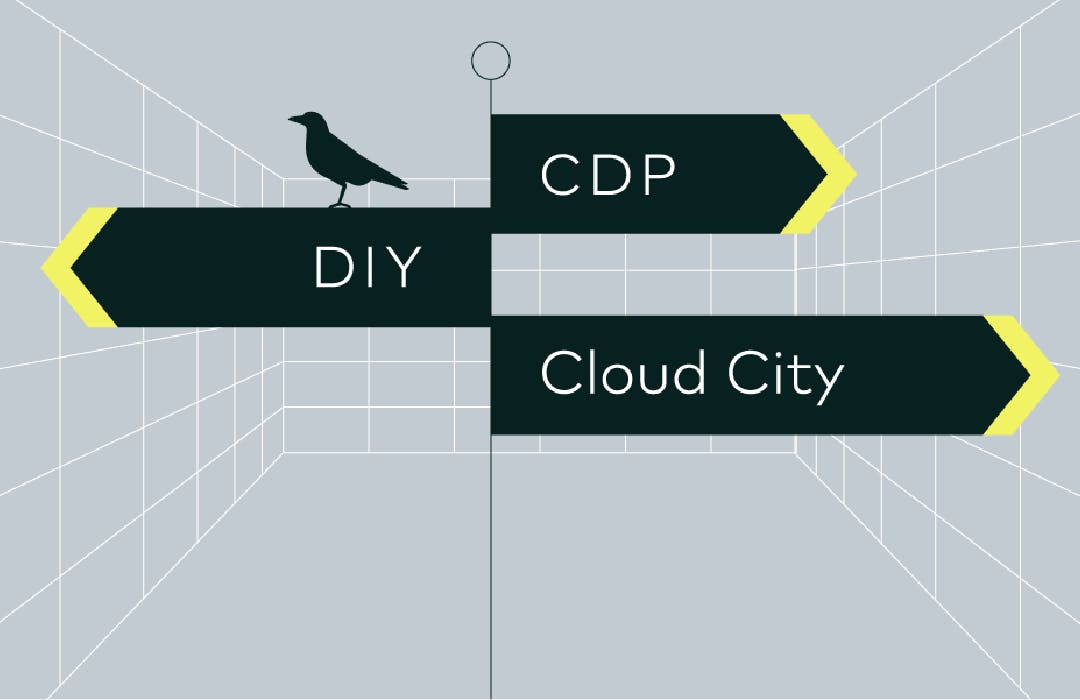If you want to turn your customer data into better service for your customers and a competitive advantage for your business, you have three choices: buying from a standalone Customer Data Platform (CDP) vendor, adding new products from your marketing suite, or building a solution in-house. Or as we like to think of it, you can find a friend, join a club, or go it alone. All three approaches aim at the same destination, but each will take you down a different path.
Build In-House (Go it Alone)
Pro: Own your own tech
Con: Super-heavy lift with many pitfalls
Marketing Suite (Join the Club)
Pro: Brands you know
Con: Hard to hang out with non-members (even though you might want to)
Standalone CDP (Find a Friend)
Pro: Some of these guys are experts
Con: You have to know how to spot the experts
We encourage companies to evaluate based on specific business goals and outcomes, rather than comparing checklists of features; after all, marketers don’t really care about which widgets work best, they just want to keep their existing customers happy and find new customers who stick around.
With all the noise and buzz and hype around Customer Data Platforms, it’s easy to lose sight of what they were designed for in the first place: to turn what you know about your customers into better experiences for them, which translates into value for your business.
Giving customers a reason to love your brand is of course an old goal for marketers, but advancements in technology now make it possible at much greater speed and scale. The question now is not whether to use a tech solution but which one.
Go it Alone?
The appeal of building CDP capabilities in-house is that you control the whole project from start to finish and can build it exactly to your specifications. You know your needs better than anyone else does.
The difficulty is that this is not a quick or simple build. Making the most of customer data involves multiple steps. First you have to organize the data in an accurate and accessible way that stays up-to-date with new inputs from anywhere the customer interacts with your brand. Then build tools for advanced segmentation and predictive models. Finally you need smooth delivery of the data to the people and channels where it can power great campaigns and experiences for your customers.
Any one of those areas can be full of snarls and road bumps, and the people who are best at it are doing it with the benefit of years of experience and often with proprietary technology. Starting from scratch involves figuring it out as you go. Even if you hire developers who have experience with CDP functionality, it will still take them time to build everything you need and then iron out the kinks so that it works properly — and value inside a few months is much more attractive than value sometime down the road.
Join the Club?
2019 was the year that major marketing clouds threw their hats in the CDP ring. Before the year was out, Salesforce, Microsoft, Adobe, and Oracle had all launched or announced that they would be launching their own CDP offerings.
Going with one of these marketing suites can offer a sense of security and reliability because these companies have been around for decades.
The downside is that your customer data can only really be put to work within the software ecosystem of whichever cloud vendor you hang out with. Offerings from “the big guys” are optimized for (and often times lock you into) interacting with their other products, providing less flexibility for a customized solution. These offerings are also of variable quality, having been acquired and shoehorned into the cloud rather than being purpose-built to meet your business where it’s at.
Find a Friend — But Make Sure it’s the Right Friend
Specialized CDP vendors do nothing but focus on the different elements of putting customer data to use. They were built to solve these problems, and they’ve spent far more time than anyone else getting good at it.
The problem is, not all of them do all the things you need done equally well.
It’s a question of majors and minors. Most of the older companies calling themselves CDP vendors were built to solve one function, say, email orchestration, and then added functionality like data aggregation or predictive analytics as they grew and matured. Some have added functionality more successfully and now have a double or triple major, while others have a major and two minors.
Newer CDP vendors have the advantage of having been built with all the necessary functionality in mind, so while they may be less established they often have end-to-end expertise that others lack. CDP vendors are also laser-focused on these specific problems, and aren’t trying to juggle multiple missions and visions of how to serve their customers.
Not all CDP vendors have full functional competency, so you have to choose carefully. But with far greater flexibility than marketing suites and specific expertise that takes the long slog and trial-and-error out of building it yourself, a specialized vendor with the right capabilities is the best positioned to deliver speed to value.
Want to talk more about which direction makes sense for you? Get in touch.
